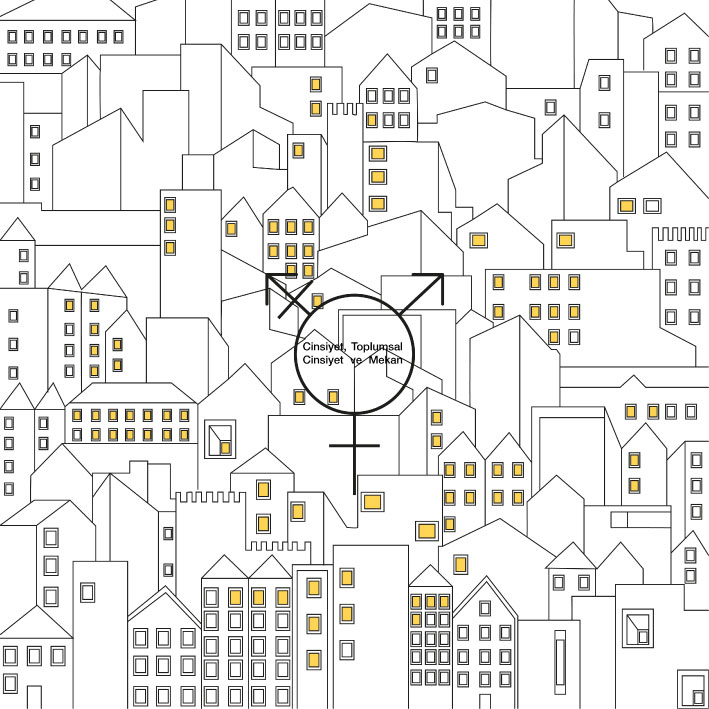
Blog | Gender and Space
Biologically speaking, people who are born as men and women take on some roles and responsibilities according to the culture they belong to (Powell and Greenhause, 2010: 1012). This reshaping of men and women according to the culture of the society they are a part of is called gender. The concept of gender is a concept that started to develop under the influence of the feminist movement in the 60s and 70s. Men and women, who differ due to their duties and responsibilities in daily life, are also exposed to various gender-based discriminations for the same reason.
Gender roles, which are accepted as much as biological characteristics, depend on many factors related to economic and social life. Therefore, it concerns not only women but also men. Gender, which does not represent a natural process unlike biological characteristics, shows that the position of women in society, in particular, is due to the sexist distinctions created by society. In every gender-based society, the roles of men and women have been determined, and a hierarchical relationship order has been established both in the family and in society.
In particular, the position of women in society is constantly discussed due to gender roles, the distinction between private and public places, and status. Since the patriarchal structure of the traditional society still exists in the modern social order, the woman has to be a good wife and mother and has been exploited under male domination for millennia. When we look at the thought from antiquity, Aristotle describes the woman as an unsuccessful attempt to form a male child. It is seen that the bad luck determined by traditional societies for women in the historical process continues today. Even today, the low social status of women in social life can even be attributed to their socioeconomic weakness (Çukurçayır, 2006: 86-88). For example, motherhood, which is the most important social role imposed on women, appears as an element that makes her dependent on the home. Motherhood is not a profession, and since it is not counted as a production activity, there is no reward for the effort spent. According to gender roles, the most important role of men is to provide for the family (breadwinner), while the most important duty of women is to ensure the continuity of family life (Moya, Exposito, and Ruiz, 2000: 825).
The development of the gender role is directly related to the upbringing method of the family as defined by Freud. Freud attributes the development of these roles to the function of gender rather than sociological differences. For Freud, anatomy is destiny. So is this assumption really true?
Are men and women differently because they are anatomically different, or are they different because they have been taught to be different? Is biology an immutable destiny?
The role of the environment is very important in the formation process of gender. In particular, the cultural environment emerges as an important element in the formation of gender. In this sense, space and socio-economic relations are among the determinants that affect gender. Therefore, one of the most important factors affecting the conceptualizations of women and space interactions is women’s labor force participation. More importantly, this phenomenon is the starting point of the dilemmas that need to be overcome in the discussion on the interaction of women and space (Kayasü, 2006).
Women are pushed into the background in working life due to the domestic work done for the reproduction of society, which has no monetary value but occupies almost the majority of the woman’s time. Women who spend most of their time at home have less visibility in the public and can participate in business life with limited opportunities, are pushed to low-status and low-paid jobs with limited advancement opportunities, and are deemed worthy of a secondary position (Çiçekli, 2019). The feminist theory argues that this reality is seen as a favor to women with the dominance of the patriarchal structure of gender roles. (Özçatal, 2011; Hartmann, 2006). The patriarchy, which we will define as men’s domination over women, aims to keep women under control in paid jobs both at home and in the public sphere (Kimura, 1999; Kandiyoti, 1997: 50-58). Thus, it is seen that women are limited both in private and public areas.
However; in the 19th century, the differentiations that occurred in the places where individuals spent time and worked caused the separation of workplace and home spaces, and this situation increased the use of public space in women’s social life. The transformation, which includes the transition from home-workshop to today’s home-workplace differentiation, which is a characteristic of pre-industrial society, is closely related to both the differentiation of gender roles and the identification of different gender roles with different spaces. In short, the processes of differentiation in space and identification of gender with certain spaces have developed in parallel with each other (Özyaşar, 2011). The term “gendered spaces” is used in relation to the concept of gender in architecture. The most obvious examples of gendered spaces are spaces that try to separate men and women. In addition to creating two different spaces for two different genders, this understanding sometimes defines wider spaces for the opposite sex by restricting one gender (usually women).
Is the home protective or restrictive?
In some societies, it is widely believed that keeping women away from the public sphere is a necessity that protects the family and especially women. This is one of the most important factors that determine the use of space by men and women. According to this understanding, a woman is confined to her home so that her family and herself are not harmed. Again, the same understanding restricts the female figure in areas outside the private space and causes the masculinization of the public space. The interaction of gender and space is also reduced to the housing scale. It is the case that the woman, who is identified with the private space, cannot have a “personal space” even in the house, which is considered as the “natural” space of her. While the man has to have privately defined areas such as the study room or the garden in the house; It is noteworthy that the living rooms and the kitchen, which are seen as women’s spaces, are not such personal spaces. In the capitalist accumulation process, which shapes the urban space with the separation of public and private spheres and assigns roles for women for the reproduction of labor at home and men for production in the public sphere, women’s limited space for movement makes it difficult for women to participate in the workforce, while restricting their access to public services. This situation causes possible differences in the perception of urban livability according to gender.
Is public space public?
Perception of livability varies according to people’s needs and welfare levels, culture, and geography. Despite this variability and relative structure, factors such as economic opportunities, socio-cultural activities, perception of space, accessibility of public services such as education, health, sports, presence of green space and recreation services, and security constitute the generally accepted bases in livability studies. In addition to all social, cultural, economic, and spatial differences, gender is a very important variable for livability studies (Keçeli, 2012). Because, urban spaces reveal a sociological reality in which unequal power relations are produced between different genders and these power relations are somehow normalized and accepted over time. For this reason, urban studies constitute the basis of socio-cultural research as well as architectural and anthropological research. Gender-based conflicts between the different sexes and inequalities in access to opportunities require an in-depth analysis of the urban space. Because, the gender of urban spaces often limits access to available resources.
Ceren Tüfek
References:
[1] Toplumsal Cinsiyet Eşitsizliği, Cinsiyetleşmiş Mekanlar
Çiçekli, A. (2019). “Evinin Hanımı Çocuklarının Anası” Olan Kadının Kamusal Alan Mücadelesi. Sosyal Bilimler Araştırma Dergisi, 8(1), 1-14.
[2] Çukurçayır, A. (2006). Siyasal Katılma ve Yerel Demokrasi: Küreselleşme Sürecinde Yurttaş, Yönetim, Siyaset. İstanbul: Çizgi Kitabevi.
[3] Kayasü, S., (2006). ‘’Kadın ve Mekan Etkileşimi’’, İstanbul.
[4] Keceli, A., (2012). Effects of Rapid Urbanization on Lıvability in Turkish Cities: A Case Study of Denizli, University of Oklahoma Graduate College, Norman, US.
[5] Kimura, D. (1999). ‘Best person not always hired under affirmative action’ [Opinion]. Simon Fraser News. 16. http://www. sfu.ca/ mediapr/sfnews/1999/nov4/kimura.html (erişim: 12.10.2017).
[6] Özçatal, E. Ö. (2011). ‘Ataerkillik, Toplumsal Cinsiyet ve Kadının Çalışma Yaşamına Katılımı’. Çankırı Karatekin Üni. İktisadi ve İdari Bilimler Fakültesi Dergisi. Cilt 1. Sayı 1. Güz. 21-39
[7] Özyaşar, M. Kadın ve Mekan. Bültene Yazı Gönderenlerin Dikkatine, 8.
[8] Powell, G.N. ve Greenhaus, J.H. (2010). ‘Sex, Gender, and Decisions at The Family – Work Interface’. Journal of Management. 36 4,1011-1039.

